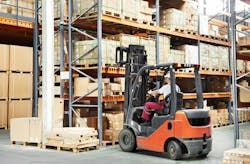Factors Affecting Forklift Market Forecast
Several factors are currently influencing the forklift market, including uneven growth across different regions, the shift toward electric models, and the introduction of new US tariffs. Interact Analysis released an analysis of the situation.
(The following is an excerpt from the analysis. )
The Impact of US Tariffs: Immediate Reactions and Strategic Adjustments
The introduction of substantial US tariffs in April 2025 led to immediate market responses:
- Initial Hesitation: Customers adopted a cautious stance, requesting production halts and shipment delays.
- Grace Period Surge: Once a tariff grace period was negotiated, there was a significant increase in “rush shipments” as importers aimed to bring in goods before the tariffs fully came into effect.
- 2025 Projection: A moderate decrease in shipments from China to the US is anticipated for 2025, although not a drastic decline. The pre-tariff stockpiling and rush of shipments are expected to mitigate the immediate impact.
The impact of US tariffs for Chinese exports varies dramatically across forklift segments:
Class 1 & Class 4/5: High impact. Historically, the price gap between Chinese imports and established brands (e.g., Toyota, Crown) in the US was relatively narrow. Tariffs severely erode the cost advantage, making imports significantly less competitive.
Class 2: Significant impact. This segment faces intense competition from US manufacturing powerhouses Crown and Raymond. High tariffs eliminate the landed cost advantage of Chinese imports, making domestically produced options the clear choice for most US buyers.
Class 3.1: Minimal impact. Chinese brands dominate this segment in the US with a monopoly-like market share. Key competitors show limited focus here. The substantial inherent cost/performance advantage of Chinese class 3.1 trucks means they remain essential for US buyers even after tariffs. Demand is expected to hold relatively firm.
North America: High costs suppress demand
Interest rates and tariffs: The Federal Reserve’s sustained high interest rates have caused an increase in corporate financing costs. Additionally, the US tariffs on forklifts from China (with some models facing a rate of up to 25%) have weakened the price advantage of Chinese brands.
Manufacturing Weakness: North America’s forklift utilization rate has dropped to 46.9% (as of January 25) with a 12.6% month-on-month decrease in operating hours, reflecting a contraction in productivity.
Electrification: Progress amid regional variations
The transition towards electric power sources continues but varies from region to region and there is significant divergence in Class 3 lithium-ion adoption. While adoption progresses in Europe and Asia, the North American market has seen a notable slowdown in the Class 3 (electric warehouse trucks, including pallet jacks and stackers) market. Factors such as high interest rates are affecting fleet investment decisions and companies are focusing on immediate cost savings over long-term total cost of ownership (TCO). However, the shift from diesel to electric in counterbalance trucks remains a steady and sustained global trend, mainly due to lower operating costs and more stringent emissions regulations.
Short-term dynamics: Signs of stabilization emerge
After a prolonged period of inventory digestion lasting over a year (evident in declining order growth since 2022-2023), the global market is showing tentative signs of stabilization:
- Order Recovery: A critical signal emerged in Q4 2024-Q1 2025, with industry giants Toyota and KION reporting a~9% quarter-on-quarter increase in order backlogs. This suggests channel inventory drawdown is nearing completion.
- Potential Catalysts: A recovery in Chinese manufacturing PMI and subsequent overseas channel restocking could fuel a demand rebound in late 2024/2025.
- Good Profitability Outlook: Favorable conditions persist for manufacturers. Low and stable domestic raw material costs in China, coupled with a growing proportion of higher-margin overseas revenue (boosted by forex benefits), support expectations for sustained robust profit margins through 2025.
